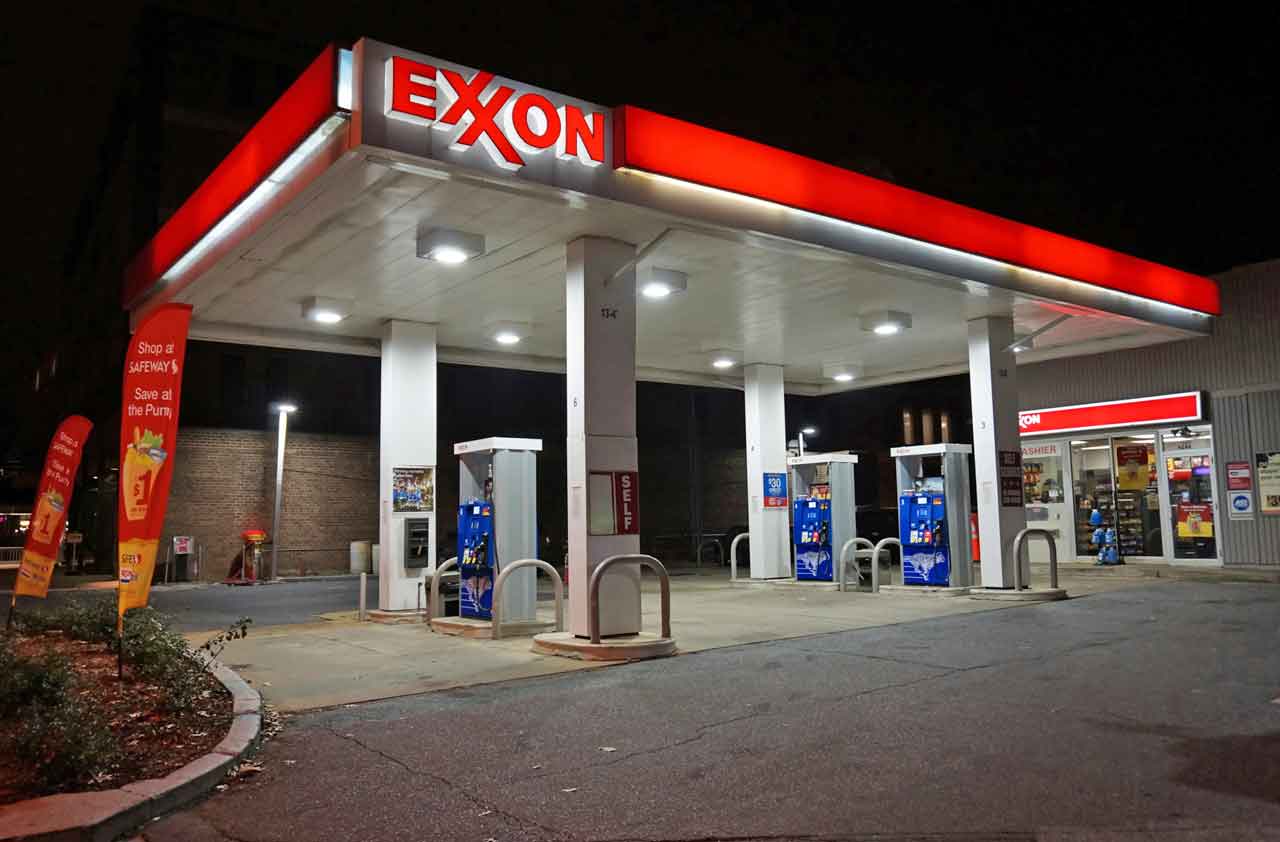Good Reasons to Buy and Hold Exxon Stock Forever
Exxon pays a generous dividend and, despite losing its coveted triple-A credit rating, the energy giant’s finances are rock solid.


Until April 26, only three publicly traded companies warranted a coveted triple-A bond rating. But on that day, the number fell to two when Standard & Poor’s downgraded the rating of ExxonMobil (symbol XOM) to double-A-plus. How did stock investors react? Essentially by letting out a collective yawn. The stock actually rose on the day the downgrade was announced, by all of 30 cents a share.
Sure, the energy giant’s debt load has more than tripled over the past two years. And yes, lower oil prices drag down the bottom line. But this is Exxon we’re talking about—a company that supplies about 4% of the world’s energy needs, producing the equivalent of more than four million barrels of oil and natural gas a day. Most energy producers would be thrilled to earn a double-A rating. S&P may have landed a punch with its downgrade, but it will take a lot more than that to knock down Exxon’s stock. (Moody’s, which continues to rate Exxon triple-A, put it on a negative ratings outlook in February and may be next to downgrade the firm. The other remaining triple-A-rated companies, according to both S&P and Moody’s, are Johnson & Johnson and Microsoft.)
In fact, Exxon is one of the few stocks likely to deliver solid returns for the next decade or more. With a market value of $367 billion, the Irving, Tex.-based firm towers over every other energy producer, both globally and in the U.S. Analysts expect the company to haul in $222 billion in revenues this year. That’s down sharply from record sales of $468 billion in 2011, but it still beats almost every other company on the planet. At current production rates, the firm’s proven oil-and-gas reserves would last for the next 16 years.
From just $107.88 $24.99 for Kiplinger Personal Finance
Become a smarter, better informed investor. Subscribe from just $107.88 $24.99, plus get up to 4 Special Issues

Sign up for Kiplinger’s Free Newsletters
Profit and prosper with the best of expert advice on investing, taxes, retirement, personal finance and more - straight to your e-mail.
Profit and prosper with the best of expert advice - straight to your e-mail.
Smaller energy companies offer more growth potential. And their stocks would surge much more if oil prices jump back to $70 per barrel or more, up from the current price of $45.30. Yet most major producers have posted steep losses as oil prices crashed, taking their stocks down by 30% or more. Exxon has managed to stay profitable, reporting $16.1 billion in net income last year. The stock, at $88.49, has held most of its value, too, trading just 15% below its all-time high of $104 a share, reached in June 2014. (All current prices are as of April 27.)
A good source of dividend income
Amid the carnage in the oil patch, Exxon even managed to hike its dividend in 2015—the 33rd straight year it had done so. Its stock now yields 3.3%, well above the 2.2% yield of Standard & Poor’s 500-stock index. Exxon announced another dividend increase on April 27, hiking its quarterly payout from 73 cents a share to 75 cents. Although profits have come down sharply, the company reported first-quarter results on April 29 that beat Wall Street forecasts.
Even though Exxon may not have much growth in its tank, the company should generate piles of cash. Indeed, oil doesn’t have to budge much above current prices for Exxon to maintain current production levels and fund its dividend with profits from oil-and-gas and refined product sales through 2020, according to Bank of America Merrill Lynch. If the price of oil rebounds into the $70s, Exxon’s financial picture would look much brighter.
Exxon does face some steep challenges. After spending heavily on acquisitions, share buybacks and production in recent years, Exxon now carries an estimated $36.2 billion in long-term debt, up from $11.7 billion in 2014—one reason S&P downgraded the firm. That wouldn’t be so bad if the company wasn’t spending more than it’s making on an operating basis. Yet Moody’s expects Exxon’s capital expenses and dividends to exceed its operating cash flow by about $10 billion in 2016. Moody’s expects Exxon to remain in the hole in 2017, albeit at a diminished level.
The future looks bright
Long-term, Exxon will have to spend more heavily to replenish its reserves. Exxon replaced just 67% of its reserves in 2015, largely because of a decline in natural-gas drilling in North America. The company has replaced 115% of reserves over the past decade, and it will need to boost drilling sharply just to replenish 100% of the oil and gas it extracts.
Buying smaller energy producers or snapping up their assets would help the firm refill its coffers. Still, Exxon cut spending on exploration and production as oil prices sank; the company plans to shell out $23.2 billion this year, down from $31.1 billion in 2015. Eventually, Exxon will have to make acquisitions or ramp up spending, potentially choking profits if oil prices don’t climb.
Yet even in a low-price environment, Exxon’s competitive advantages should help it thrive. The firm’s cost of producing a barrel of oil or the equivalent amount of gas is lower than that of most major competitors. Its return on capital (a measure of profitability) has beaten every other big rival in recent years. Exxon’s refinery system—capable of processing 6.4 million barrels of crude oil a day—also benefits from lower oil prices, helping the firm’s overall profits stay afloat.
Exxon is likely to be the sole major producer to report a profit in the first quarter of 2016, says Merrill Lynch. Exxon earned 43 cents a share in the quarter. That’s a steep 63% decline from the $1.17 a share the firm earned in the same period a year earlier. Yet Exxon’s profits stand in sharp contrast to the rest of the industry, which is likely to be in the red.
Exxon will never be a sizzler in the energy patch. But the firm’s diversified businesses and financial resilience should make it a solid long-term bet. Over the past 15 years through April 27, the shares returned an annualized 6.4%, including dividends, compared with 5.2% annualized for the average large diversified energy company, according to Morningstar. Assuming that the world doesn’t stop burning fossil fuels, Exxon’s returns over the next 15 years shouldn’t be any different.
Profit and prosper with the best of Kiplinger's advice on investing, taxes, retirement, personal finance and much more. Delivered daily. Enter your email in the box and click Sign Me Up.

-
 States That Tax Social Security Benefits in 2026
States That Tax Social Security Benefits in 2026Retirement Tax Not all retirees who live in states that tax Social Security benefits have to pay state income taxes. Will your benefits be taxed?
-
 QUIZ: What Type Of Retirement Spender Are You?
QUIZ: What Type Of Retirement Spender Are You?Quiz What is your retirement spending style? Find out with this quick quiz.
-
 How to Avoid the Financial Quicksand of Early Retirement Losses
How to Avoid the Financial Quicksand of Early Retirement LossesSequence of returns — experiencing losses early on — can quickly deplete your savings, highlighting the need for strategies that prioritize income stability.
-
 'Donroe Doctrine' Pumps Dow 594 Points: Stock Market Today
'Donroe Doctrine' Pumps Dow 594 Points: Stock Market TodayThe S&P 500 rallied but failed to turn the "Santa Claus Rally" indicator positive for 2026.
-
 If You'd Put $1,000 Into Lowe's Stock 20 Years Ago, Here's What You'd Have Today
If You'd Put $1,000 Into Lowe's Stock 20 Years Ago, Here's What You'd Have TodayLowe's stock has delivered disappointing returns recently, but it's been a great holding for truly patient investors.
-
 If You'd Put $1,000 Into 3M Stock 20 Years Ago, Here's What You'd Have Today
If You'd Put $1,000 Into 3M Stock 20 Years Ago, Here's What You'd Have TodayMMM stock has been a pit of despair for truly long-term shareholders.
-
 Stocks Chop as the Unemployment Rate Jumps: Stock Market Today
Stocks Chop as the Unemployment Rate Jumps: Stock Market TodayNovember job growth was stronger than expected, but sharp losses in October and a rising unemployment rate are worrying market participants.
-
 If You'd Put $1,000 Into Coca-Cola Stock 20 Years Ago, Here's What You'd Have Today
If You'd Put $1,000 Into Coca-Cola Stock 20 Years Ago, Here's What You'd Have TodayEven with its reliable dividend growth and generous stock buybacks, Coca-Cola has underperformed the broad market in the long term.
-
 What Fed Rate Cuts Mean For Fixed-Income Investors
What Fed Rate Cuts Mean For Fixed-Income InvestorsThe Fed's rate-cutting campaign has the fixed-income market set for an encore of Q4 2024.
-
 If You Put $1,000 into Qualcomm Stock 20 Years Ago, Here's What You Would Have Today
If You Put $1,000 into Qualcomm Stock 20 Years Ago, Here's What You Would Have TodayQualcomm stock has been a big disappointment for truly long-term investors.
-
 If You'd Put $1,000 Into Home Depot Stock 20 Years Ago, Here's What You'd Have Today
If You'd Put $1,000 Into Home Depot Stock 20 Years Ago, Here's What You'd Have TodayHome Depot stock has been a buy-and-hold banger for truly long-term investors.